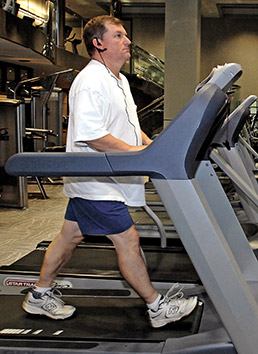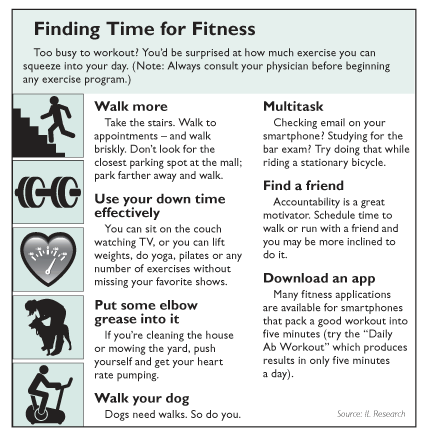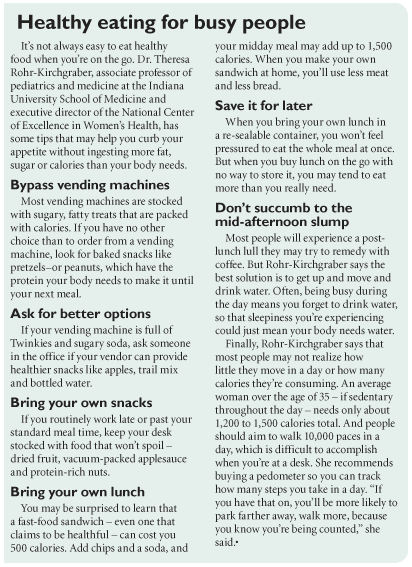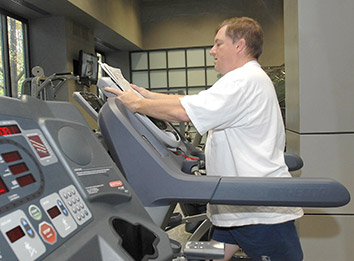Subscriber Benefit
As a subscriber you can listen to articles at work, in the car, or while you work out. Subscribe NowAttorney Michael Gabovitch said he generally works from 8 a.m. to 7 p.m. Monday through Friday, plus a few hours on the weekend. The busy father of four doesn’t have much free time, but he’s found a way to make time for fitness.
Gabovitch used to exercise in the evenings. But because his office at Katz & Korin in downtown Indianapolis is just a few blocks from the fitness center in the OneAmerica Tower, he found that he could make better use of his time exercising during the day.
“Whenever I find I have an ability to sneak out for a little while, I head over there,” he said.
Gabovitch is among a handful of attorneys who use the equipment in the downtown gym. And incoming Indiana State Bar Association president C. Erik Chickedantz would like to see more lawyers finding time to get away from their desks.
Chickedantz has spearheaded the bar’s new Wellness Committee in an effort to promote a healthy lifestyle for attorneys.
“The idea behind this is not to tell judges and lawyers how they ought to live their lives,” he said. “But being a lawyer, being a judge is, for a number of reasons, a high-stress environment. High stress over a period of time has a lot of byproducts, and most of them are bad.”
To each his own
Mark Waterfill works in the OneAmerica building at Benesch Friedlander Coplan & Aronoff.
Three to four days a week, he puts in 30 or 45 minutes on the gym’s treadmill or elliptical trainer.
 Mark Waterfill, partner at Benesch Friedlander Coplan & Aronoff, takes a late-afternoon break to exercise in the OneAmerica Tower fitness center. (IL Photo/ Perry Reichanadter)
Mark Waterfill, partner at Benesch Friedlander Coplan & Aronoff, takes a late-afternoon break to exercise in the OneAmerica Tower fitness center. (IL Photo/ Perry Reichanadter)“I’m not the picture of a fitness person – I’m a low-impact fitness person,” he said. “My doctor recommended, rather than trying to go on some kind of strict diet, to just try to make sure that I exercise at least 30 minutes a day, five days a week.”
The Centers for Disease Control and Prevention recommends adults get at least 2 hours and 30 minutes of moderate-intensity aerobic activity every week – and that could be walking briskly, riding a bike or pushing a lawn mower – along with muscle strengthening. Body-weight exercises like push ups and sit ups can be part of a weekly muscle-strengthening program. And while the CDC recommendations may sound overwhelming, breaking up exercise into 10-minute increments may make it more manageable.
Collateral benefits
In addition to feeling physically healthier, Gabovitch sees other benefits to regular exercise.
“Even more so than the physical benefit is just the mental benefits of knowing you’re doing something for yourself – getting exhausted and sweatin g is just therapeutic, and I think it helps keep you sharp not only physically, but mentally,” he said.
g is just therapeutic, and I think it helps keep you sharp not only physically, but mentally,” he said.
Taking time away from the office to exercise allows him to be alone with his thoughts, Gabovitch explained, while not having to worry about incoming calls or other matters.
“That time that I’m working out during the day is one of the few times during the day where I’m really by myself,” he said.
Chickedantz, who was a runner when he was younger but now gets much of his exercise through golf and trips to the gym, also understands the mental benefits of exercise.
“Google ‘regular exercise’ and ‘stress,’ and you’ll find that it helps reduce stress in most people,” he said. “It’s not rocket science.”
Chickedantz said that he admires the Indiana Supreme Court Judges and Lawyers Assistance Program. Attorneys who run afoul of codes of conduct and end up in JLAP support programs could possibly have avoided those problems by being better to their bodies – exercising, eating properly, drinking alcohol only in moderation and giving up smoking.
“(JLAP) gets involved when the horse has bolted out of the barn,” Chickedantz said. “So last year, we thought, let’s think of doing something proactive.” JLAP executive director Terry Harrell is a member of the Wellness Committee.
Chickedantz said that the Wellness Committee is still a work in progress, but it has developed a wellness plan law firms can adopt.
Wellness in the workplace
Stephanie Smithey, an attorney for Ogletree Deakins Nash Smoak & Stewart, often helps companies craft wellness plans, and it’s a practice that’s caught on in recent years, she said.
“In the early 90s, nobody ever talked about wellness plans,” she said. “After the 90s, you started hearing about this as a concept, and little by little, employers started initiating this in the workplace.”
 Smithey
SmitheySmithey, co-author of the Indiana Employer’s Guide to Workplace Wellness, said any company that is considering developing a formal workplace wellness plan – one that ties employee health to reduced health care premiums – should seek the input of an attorney familiar with that area of law. But plans that are not directly tied to insurer discounts are relatively easy to put together, she said.
“Let’s say you’re a law firm, and you want to have an annual wellness fair – that can be a very informal program,” she said. “There are going to be very few hoops to jump through.” But she said that if an employer were to offer a health insurance discount to someone who tests within a healthy blood pressure range, that would introduce a “whole range of laws” that employers would need to carefully consider.
Neither Gabovitch nor Waterfill work at firms with wellness plans, they said, although Gabovitch said he’s developing a proposal for such a plan to be implemented next year.
What’s next
The Wellness Committee kicked off events at the ISBA’s annual meeting this year with a 5K run/walk. About 40 people attended, and Chickedantz said, “We’re hopeful that a couple years from now, we may have hundreds.”
The committee will look at ways to partner with other similar events that already have a robust following, like the Susan G. Komen For the Cure race.
Creating and organizing new fitness events is a lot of work, and Indianapolis already has quite a few of those, Chickedantz said. “So our idea was to try to be a small-time collaborator with those events and try to get as many lawyers, judges, law students involved, and at least have a presence.”
Chickedantz said the committee is also working to develop wellness committees in Indiana’s four law schools because law students also encounter a lot of stress in their academic pursuits.
Waterfill said that lawyers, for their own well being, must learn how to break away from their work.
“We get so wrapped up in our work that, a lot of times, it’s hard to make yourself do that,” he said.
Chickedantz agrees that simply making a commitment to get moving can have a profound positive impact on personal health. For example, he said that regardless of anyone’s political views, people would be hard-pressed to disagree with the principles of First Lady Michelle Obama’s “Let’s Move!” campaign, which aims to curb childhood obesity by advocating for healthier eating and increased physical activity.
“If the whole society would pick up on that idea – and this is a big overgeneralization – the healthcare problems that we’ve got today, 30 or 40 years from now, would go away if people across the board would focus on wellness,” he said. “The best health insurance policy as far as I’m concerned is to not get sick, stay healthy.”•
Please enable JavaScript to view this content.

